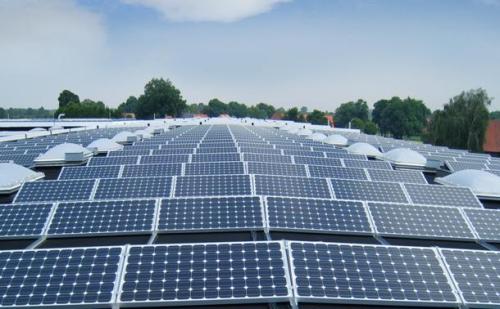 China has become a global leader in the photovoltaic (PV) industry, with six or seven of the top ten module manufacturers worldwide being Chinese companies. In 2012, the country installed approximately 4.5 GW of new solar capacity, marking a 66% year-on-year increase and capturing around 14% of the global market share. The industry's total output value exceeded 300 billion yuan, and it provided employment for nearly 500,000 people.
For sustainable growth, the PV sector must adopt a robust business model and move toward a more market-oriented development path. This shift is crucial not only for long-term stability but also for ensuring that clean energy can be effectively integrated into the national grid.
Jinko Energy CEO Chen Kangping, a representative of the National People’s Congress, emphasized several key steps to support this transition. First, legal frameworks must ensure that solar power plants are connected to the grid and operate efficiently. New policies like the "Administrative Measures for Priority Access to Renewable Energy for Power Generation" are being developed to address challenges in purchasing renewable energy. Additionally, the long-awaited "Administrative Measures on Renewable Energy Power Quotas" is expected to be introduced soon, which will help resolve issues related to full utilization of solar and wind power.
Second, timely subsidies for solar power stations are essential. A balanced approach should consider the interests of power plant operators, grid companies, and end consumers. Subsidies should also support grid upgrades, peak power supply, and solar generation to maximize the use of clean energy. These measures can significantly boost the development and adoption of renewable energy.
Third, improving regulations for distributed power systems is vital. As China expands its use of decentralized solar installations, legal uncertainties remain. Issues such as rooftop ownership, compensation standards, and rights between building owners and solar operators need clear definitions to foster trust and investment.
Fourth, commercialization is a key indicator of market maturity. Policies should allow power station owners to use their generated electricity and sell surplus to the grid. Removing regulatory barriers will encourage private and foreign investors to participate, creating a competitive and dynamic market environment that attracts long-term capital.
Finally, detailed implementation rules must be clarified to refine business models. Many aspects of current policies—such as subsidy duration, distribution mechanisms, and land-use regulations—remain unclear. Addressing these gaps will provide greater certainty for stakeholders.
Shi Yubo, a member of the Chinese People’s Political Consultative Conference, highlighted the importance of reforming and innovating supporting policies. He proposed revising the subsidy mechanism for grid-connected solar power and introducing a benchmark pricing system to better regulate the industry’s growth. He also recommended further research into distributed generation laws, developing fair pricing policies, accelerating the creation of application standards, and establishing a compensation mechanism for grid companies that absorb solar power. These steps aim to motivate all market participants and ensure a sustainable future for China’s solar industry.
China has become a global leader in the photovoltaic (PV) industry, with six or seven of the top ten module manufacturers worldwide being Chinese companies. In 2012, the country installed approximately 4.5 GW of new solar capacity, marking a 66% year-on-year increase and capturing around 14% of the global market share. The industry's total output value exceeded 300 billion yuan, and it provided employment for nearly 500,000 people.
For sustainable growth, the PV sector must adopt a robust business model and move toward a more market-oriented development path. This shift is crucial not only for long-term stability but also for ensuring that clean energy can be effectively integrated into the national grid.
Jinko Energy CEO Chen Kangping, a representative of the National People’s Congress, emphasized several key steps to support this transition. First, legal frameworks must ensure that solar power plants are connected to the grid and operate efficiently. New policies like the "Administrative Measures for Priority Access to Renewable Energy for Power Generation" are being developed to address challenges in purchasing renewable energy. Additionally, the long-awaited "Administrative Measures on Renewable Energy Power Quotas" is expected to be introduced soon, which will help resolve issues related to full utilization of solar and wind power.
Second, timely subsidies for solar power stations are essential. A balanced approach should consider the interests of power plant operators, grid companies, and end consumers. Subsidies should also support grid upgrades, peak power supply, and solar generation to maximize the use of clean energy. These measures can significantly boost the development and adoption of renewable energy.
Third, improving regulations for distributed power systems is vital. As China expands its use of decentralized solar installations, legal uncertainties remain. Issues such as rooftop ownership, compensation standards, and rights between building owners and solar operators need clear definitions to foster trust and investment.
Fourth, commercialization is a key indicator of market maturity. Policies should allow power station owners to use their generated electricity and sell surplus to the grid. Removing regulatory barriers will encourage private and foreign investors to participate, creating a competitive and dynamic market environment that attracts long-term capital.
Finally, detailed implementation rules must be clarified to refine business models. Many aspects of current policies—such as subsidy duration, distribution mechanisms, and land-use regulations—remain unclear. Addressing these gaps will provide greater certainty for stakeholders.
Shi Yubo, a member of the Chinese People’s Political Consultative Conference, highlighted the importance of reforming and innovating supporting policies. He proposed revising the subsidy mechanism for grid-connected solar power and introducing a benchmark pricing system to better regulate the industry’s growth. He also recommended further research into distributed generation laws, developing fair pricing policies, accelerating the creation of application standards, and establishing a compensation mechanism for grid companies that absorb solar power. These steps aim to motivate all market participants and ensure a sustainable future for China’s solar industry.Paint Brush,Paint Brush Online,Oil Brush Photoshop,Paint Tool Sai Brush
Laizhou Chenke trading Co., Ltd. , https://www.chenkegroup.com